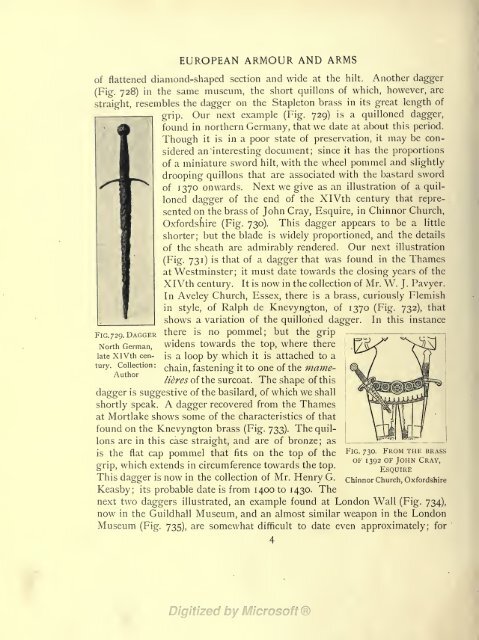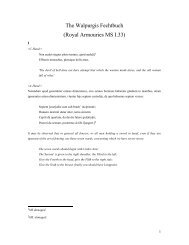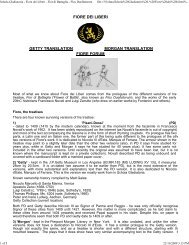- Page 7: III
- Page 11 and 12: A RECORD OF EUROPEAN ARMOUR AND ARM
- Page 13 and 14: CONTENTS OF VOLUME III CHAPTER XIX
- Page 15 and 16: CONTENTS OF VOLUME III list of the
- Page 17: CONTENTS OF VOLUME III PAf.K — Th
- Page 20 and 21: iG. EUROPEAN ARMOUR AND ARMS 743. F
- Page 22 and 23: FIG. EUROPEAN ARMOUR AND ARMS j2>oa
- Page 24 and 25: FIG EUROPEAN ARMOUR AND ARMS 817. D
- Page 26 and 27: FIG. 850. EUROPEAN ARMOUR AND arms:
- Page 28 and 29: EUROPEAN ARMOUR AND ARMS flG. PAGE
- Page 30 and 31: FIG. 922. 923- 924. 925- 926. 927.
- Page 32 and 33: 152
- Page 34 and 35: EUROPEAN ARMOUR AND ARMS KIG. PAGE
- Page 36 and 37: EUROPEAN ARMOUR AND ARMS FIG. • P
- Page 38 and 39: EUROPEAN ARMOUR AND ARMS FIG. PAGE
- Page 40 and 41: EUROPEAN ARMOUR AND ARMS FIC. PAGE
- Page 42 and 43: EUROPEAN ARMOUR AND ARMS ..........
- Page 44 and 45: EUROPEAN ARMOUR AND ARMS sider the
- Page 48 and 49: EUROPEAN ARMOUR AND ARMS only in a
- Page 50 and 51: EUROPEAN ARMOUR AND ARMS the pommel
- Page 52 and 53: Fig. 746 Fig. 747 j.
- Page 54 and 55: Fig. 754. Da(;ger of basilard type
- Page 56 and 57: H < Q
- Page 58 and 59: EUROPEAN ARMOUR AND ARMS opinion it
- Page 60 and 61: EUROPEAN ARMOUR AND ARMS of 1382, i
- Page 62 and 63: EUROPEAN ARMOUR AND ARMS provenance
- Page 64 and 65: EUROPEAN ARMOUR AND ARMS that show
- Page 66 and 67: EUROPEAN ARMOUR AND ARMS with few e
- Page 68 and 69: EUROPEAN ARMOUR AND ARMS bone now m
- Page 70 and 71: EUROPEAN ARMOUR AND ARMS simpler co
- Page 72 and 73: EUROPEAN ARMOUR AND ARMS in respect
- Page 74 and 75: EUROPEAN ARMOUR AND ARMS developed
- Page 76 and 77: EUROPEAN ARMOUR AND ARMS and at the
- Page 78 and 79: EUROPEAN ARMOUR AND ARMS weapons, t
- Page 80 and 81: EUROPEAN ARMOUR AND ARMS Williams'
- Page 82 and 83: EUROPEAN ARMOUR AND ARMS all appear
- Page 84 and 85: EUROPEAN ARMOUR AND ARMS at length
- Page 86 and 87: EUROPEAN ARMOUR AND ARMS lengthways
- Page 88 and 89: EUROPEAN ARMOUR AND ARMS has its gr
- Page 90 and 91: EUROPEAN ARMOUR AND ARMS the famous
- Page 92 and 93: EUROPEAN ARMOUR AND ARMS yataghans
- Page 94 and 95: 'iT»«i>r'- Fig. 829. Dagger Itali
- Page 96 and 97:
EUROPEAN ARMOUR AND ARMS Hispano-Ar
- Page 98 and 99:
'lG. 836. rORTKAIT OF KiNG EDWARD V
- Page 100 and 101:
[Fic. 838A Drawings of dagger shkat
- Page 102 and 103:
EUROPEAN ARMOUR AND ARMS mention a
- Page 104 and 105:
EUROPEAN ARMOUR AND ARMS are fashio
- Page 106 and 107:
EUROPEAN ARMOUR AND ARMS critic. Mo
- Page 108 and 109:
EUROPEAN ARMOUR AND ARMS The "anela
- Page 110 and 111:
Fig. 850. Blade of a cinquedea Show
- Page 113 and 114:
THE DAGGER TERMED CINQ.UEDEA limbs
- Page 115 and 116:
THE DAGGER TERMED CINQUEDEA Through
- Page 117 and 118:
75 00 00 d ^ .5 "a "^ o -J t; ° O
- Page 119:
THE DAGGER TERMED CINQUEDEA have bo
- Page 122 and 123:
EUROPEAN ARMOUR AND ARMS that delig
- Page 124 and 125:
f Fig. 864 EUROPEAN ARMOUR AND ARMS
- Page 126 and 127:
EUROPEAN ARMOUR AND ARMS lance assu
- Page 128 and 129:
Fig. 870. Swedish feather XVI th an
- Page 130 and 131:
i Fig. 871. Wy\K-riAMMER Probably F
- Page 132 and 133:
Fk;. 875. Mace head XlVth century (
- Page 134 and 135:
EUROPEAN ARMOUR AND ARMS is only th
- Page 136 and 137:
. EUROPEAN ARMOUR AND ARMS the reco
- Page 138 and 139:
Fig. 886. Knightly poleaxe AND HAM.
- Page 140 and 141:
EUROPEAN ARMOUR AND ARMS massive ha
- Page 142 and 143:
Fig. 893. From "The History of St.
- Page 144 and 145:
EUROPEAN ARMOUR AND ARMS William, E
- Page 146 and 147:
EUROPEAN ARMOUR AND ARMS appears; b
- Page 148 and 149:
EUROPEAN ARMOUR AND ARMS enrolling
- Page 150 and 151:
EUROPEAN ARMOUR AND ARMS lateral bl
- Page 152 and 153:
EUROPEAN ARMOUR AND ARMS the nature
- Page 154 and 155:
EUROPEAN ARMOUR AND ARMS Collection
- Page 156 and 157:
EUROPEAN ARMOUR AND ARMS staff, wit
- Page 158 and 159:
EUROPEAN ARMOUR AND ARMS 8, 26, 27,
- Page 160 and 161:
EUROPEAN ARMOUR AND ARMS France. In
- Page 162 and 163:
EUROPEAN ARMOUR AND ARMS d'Artiller
- Page 164 and 165:
CO Q a; w P3 a: vd M
- Page 166 and 167:
EUROPEAN ARMOUR AND ARMS must be co
- Page 168 and 169:
EUROPEAN ARMOUR AND ARMS a specimen
- Page 170 and 171:
EUROPEAN ARMOUR AND ARMS and who is
- Page 172 and 173:
EUROPEAN ARMOUR AND ARMS bow and cr
- Page 174 and 175:
EUROPEAN ARMOUR AND ARMS can be gau
- Page 176 and 177:
EUROPEAN ARMOUR AND ARMS bow, as we
- Page 178 and 179:
EUROPEAN ARMOUR AND ARMS nationalit
- Page 180 and 181:
EUROPEAN ARMOUR AND ARMS XVIth cent
- Page 182 and 183:
EUROPEAN ARMOUR AND ARMS this reaso
- Page 184 and 185:
Fig. 943. The double cords as used
- Page 186 and 187:
EUROPEAN ARMOUR AND ARMS and there
- Page 188 and 189:
EUROPEAN ARMOUR AND ARMS bow staves
- Page 190:
EUROPEAN ARMOUR AND ARMS Philip the
- Page 193 and 194:
HORSE ARMOUR were imposed upon a bl
- Page 195 and 196:
HORSE ARMOUR France apyds Philippe
- Page 197 and 198:
155 < J U! a. -r; G H < « OS W o 0
- Page 199 and 200:
157 < a: u > O u H H M o D O H U W
- Page 201 and 202:
159 X < U a. < X u si w X o 5 OS (-
- Page 203 and 204:
THE BIT Eresby, of 1395, in which t
- Page 205 and 206:
THE BIT of its fashion and manufact
- Page 207 and 208:
SPURS bronze, the neck and heel str
- Page 209 and 210:
SPURS of the Orville example, final
- Page 211 and 212:
^< SPURS thoiif(h certainly familia
- Page 213 and 214:
THE SADDLE shield with the arms of
- Page 216 and 217:
EUROPEAN ARMOUR AND ARMS The second
- Page 218 and 219:
EUROPEAN ARMOUR AND ARMS perspiring
- Page 220 and 221:
EUROPEAN ARMOUR AND ARMS small and
- Page 222 and 223:
EUROPEAN ARMOUR AND ARMS mainder of
- Page 224 and 225:
EUROPEAN ARMOUR AND ARMS of Nurembe
- Page 226 and 227:
Fig. 993. Equestrian armour Composi
- Page 228 and 229:
EUROPEAN ARMOUR AND ARMS The chanfr
- Page 230 and 231:
EUROPEAN ARMOUR AND ARMS We next il
- Page 232 and 233:
EUROPEAN ARMOUR AND ARMS which are
- Page 234 and 235:
EUROPEAN ARMOUR AND ARMS Dillon, th
- Page 236 and 237:
EUROPEAN ARMOUR AND ARMS which assu
- Page 238 and 239:
EUROPEAN ARMOUR AND ARMS direct spe
- Page 240 and 241:
EUROPEAN ARMOUR AND ARMS ordinarily
- Page 242 and 243:
Fig. loio. Model of a German jousti
- Page 244 and 245:
EUROPEAN ARMOUR AND ARMS the horse
- Page 246 and 247:
EUROPEAN ARMOUR AND ARMS Armoury of
- Page 248 and 249:
EUROPEAN ARMOUR AND ARMS these we i
- Page 250 and 251:
EUROPEAN ARMOUR AND ARMS or and arg
- Page 252 and 253:
EUROPEAN ARMOUR AND ARMS substantia
- Page 254 and 255:
EUROPEAN ARMOUR AND ARMS globose br
- Page 256:
EUROPEAN ARMOUR AND ARMS state not
- Page 259 and 260:
THE TOWER OF LONDON ARMOURY Norman
- Page 261 and 262:
Fk;. 1016. Sun ui- armulk I'Kkskntk
- Page 263 and 264:
THE TOWER OF LONDON ARMOURY Henry V
- Page 265 and 266:
Fig. ioi8. Suit ok armour for fight
- Page 267 and 268:
THE TOWER OF LONDON ARMOURY The Hen
- Page 269 and 270:
THE TOWER OF LONDON ARMOURY We ascr
- Page 271 and 272:
THE TOWER OF LONDON ARMOURY continu
- Page 273 and 274:
THE TOWER OF LONDON ARMOURY glory,
- Page 275 and 276:
THE TOWER OF LONDON ARMOURY and the
- Page 277 and 278:
235 c Q c w ^2 -5 1) 2 > O '^ c nj
- Page 279 and 280:
THE TOWER OF LONDON ARMOURY the two
- Page 281 and 282:
THE TOWER OF LONDON ARMOURY (Fig. 1
- Page 283 and 284:
THE MAXIMILIAN SCHOOL period. Durin
- Page 285 and 286:
THE MAXIMILIAN SCHOOL date was the
- Page 287 and 288:
THE MAXIMILIAN SCHOOL of the previo
- Page 289 and 290:
THE MAXIMILIAN SCHOOL worn in the b
- Page 291 and 292:
THE MAXIMILIAN SCHOOL formerly in P
- Page 293 and 294:
THE MAXIMILIAN SCHOOL of the XVth c
- Page 295 and 296:
Fig. 1037. Suit of armour (composit
- Page 297 and 298:
Fk;. 1039. Suit of armour (slightly
- Page 299 and 300:
THE MAXIMILIAN SCHOOL salient; but
- Page 301 and 302:
Fig. 1040. Suit of armour Said to l
- Page 303 and 304:
Fig. 1041. Slashed armour [/'/totog
- Page 305 and 306:
THE MAXIMILIAN SCHOOL slashed ornam
- Page 307 and 308:
THE MAXIMILIAN SCHOOL These have be
- Page 309 and 310:
Fig. 104715. The armour of THE Cons
- Page 311 and 312:
THE MAXIMILIAN SCHOOL Dear Lord Pem
- Page 313 and 314:
THE MAXIMILIAN SCHOOL The two suits
- Page 315 and 316:
LANDSKNECHT TYPE OF ARMOUR historic
- Page 317 and 318:
LANDSKNECHT TYPE OF ARMOUR of the s
- Page 319 and 320:
xvith century armour under classica
- Page 321 and 322:
xvith century armour under classica
- Page 323 and 324:
xvith century armour under classica
- Page 325 and 326:
XVlTH CENTURY ARMOUR UNDER CLASSICA
- Page 327 and 328:
XVIm CENTURY ARMOUR UNDER CLASSICAL
- Page 329 and 330:
xvith century armour under classica
- Page 331 and 332:
XVIm CENTURY ARMOUR UNDER CLASSICAL
- Page 333 and 334:
xvith century armour under classica
- Page 335 and 336:
xvith century armour under classica
- Page 337 and 338:
XVlTH CENTURY ARMOUR UNDER CLASSICA
- Page 339 and 340:
XVlTH CENTURY ARMOUR UNDER CLASSICA
- Page 341 and 342:
xvith century armour under classica
- Page 343 and 344:
xvith century armour under classica
- Page 345 and 346:
ARMOUR TERMED "SPANISH" make our ch
- Page 347 and 348:
ing ARMOUR TERMED "SPANISH" the cha
- Page 349 and 350:
ARMOUR TERMED "SPANISH" must, as we
- Page 351 and 352:
as O a, Z < U fe £ u ^^ as H CO Z
- Page 353 and 354:
ARMOUR TERMED "SPANISH" difficulty,
- Page 355 and 356:
ARMOUR TERMED "SPANISH" and on the
- Page 357 and 358:
ARMOUR TERMED "SPANISH" restrained
- Page 359 and 360:
ARMOUR TERMED "SPANISH" armour of a
- Page 361 and 362:
ARMOUR TERMED "SPANISH" arms which
- Page 363 and 364:
ARMOUR TERMED "SPANISH" circular pa
- Page 365 and 366:
ARMOUR TERMED " SPANISH " the initi
- Page 367 and 368:
ARMOUR TERMED "SPANISH" belonged to
- Page 369 and 370:
ARMOUR TERMED "SPANISH" with band.s
- Page 371 and 372:
ARMOUR TERMED "SPANISH" pieces, j^a
- Page 373 and 374:
F"l(;. 1082. A HALK SUIT OF ARMOUR
- Page 375 and 376:
THE SCHOOL OF LUCIO PICININO collar
- Page 377 and 378:
THE SCHOOL OF LUCIO PICININO "that
- Page 379 and 380:
THE SCHOOL OF LUCIO PICININO figure
- Page 381 and 382:
THE SCHOOL OF LUCIO PICININO Currie
- Page 383 and 384:
THE SCHOOL OF LUCIO PICININO with i
- Page 385 and 386:
Fig. 1089. ARMOUR TERMED " FRENCH "
- Page 387 and 388:
Fig. 1090. Suit ok armour that belo
- Page 389 and 390:
Fig. 1 09 1. Suit ov armour Made fo
- Page 391 and 392:
ARMOUR TERMED "FRENCH" Beaten out o
- Page 393 and 394:
the points of comparison which woul
- Page 395 and 396:
the armourers of Munich which are c
- Page 397 and 398:
Fig. 1096. CiiANFRON and saddle ste
- Page 399 and 400:
ARMOUR TERMED "FRENCH " we have lit
- Page 401:
LONDON: CHARLES WHITTINGHAM AND GRI









